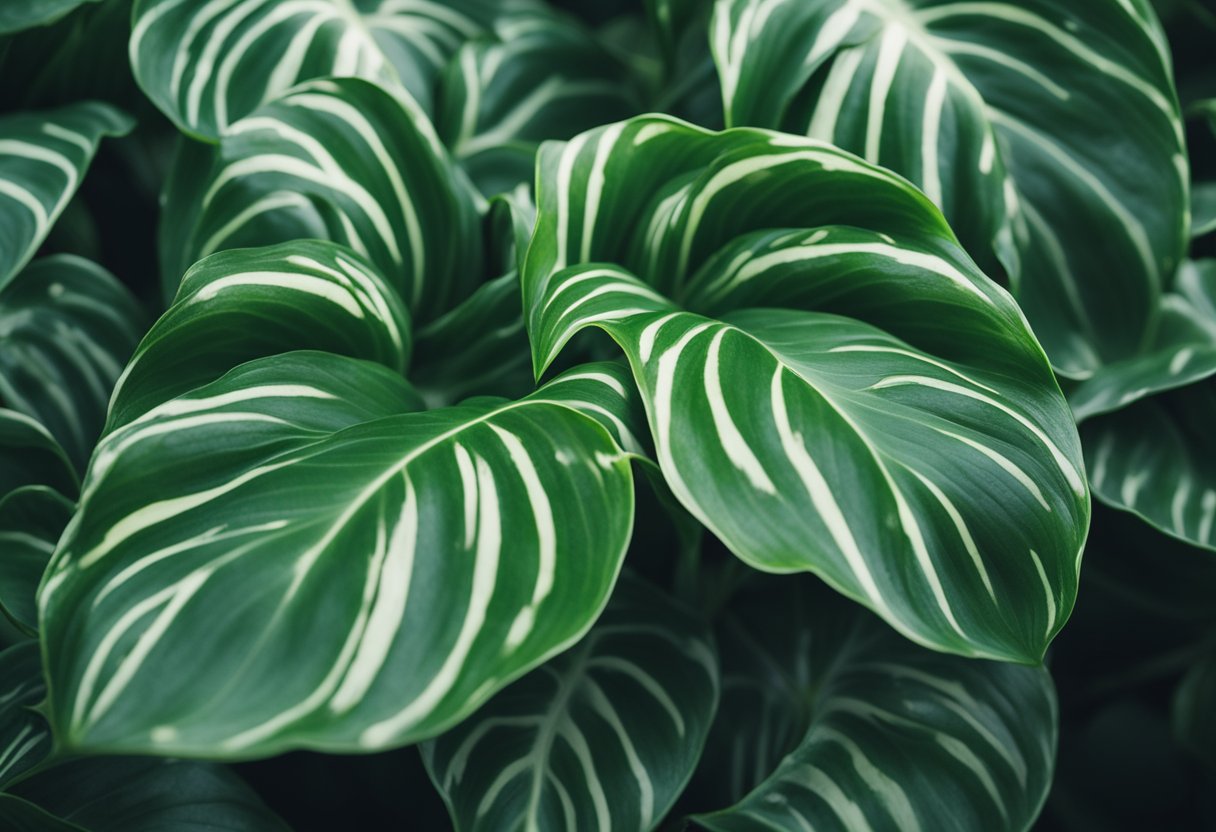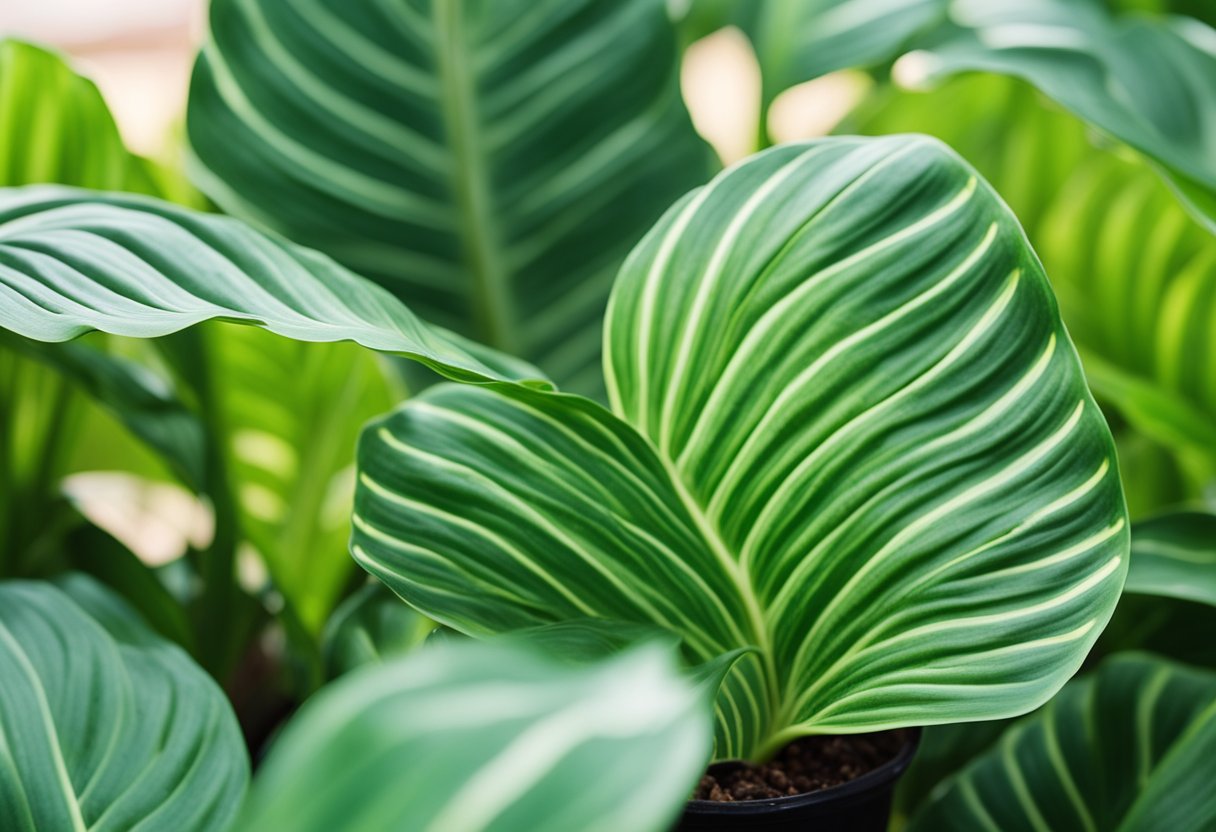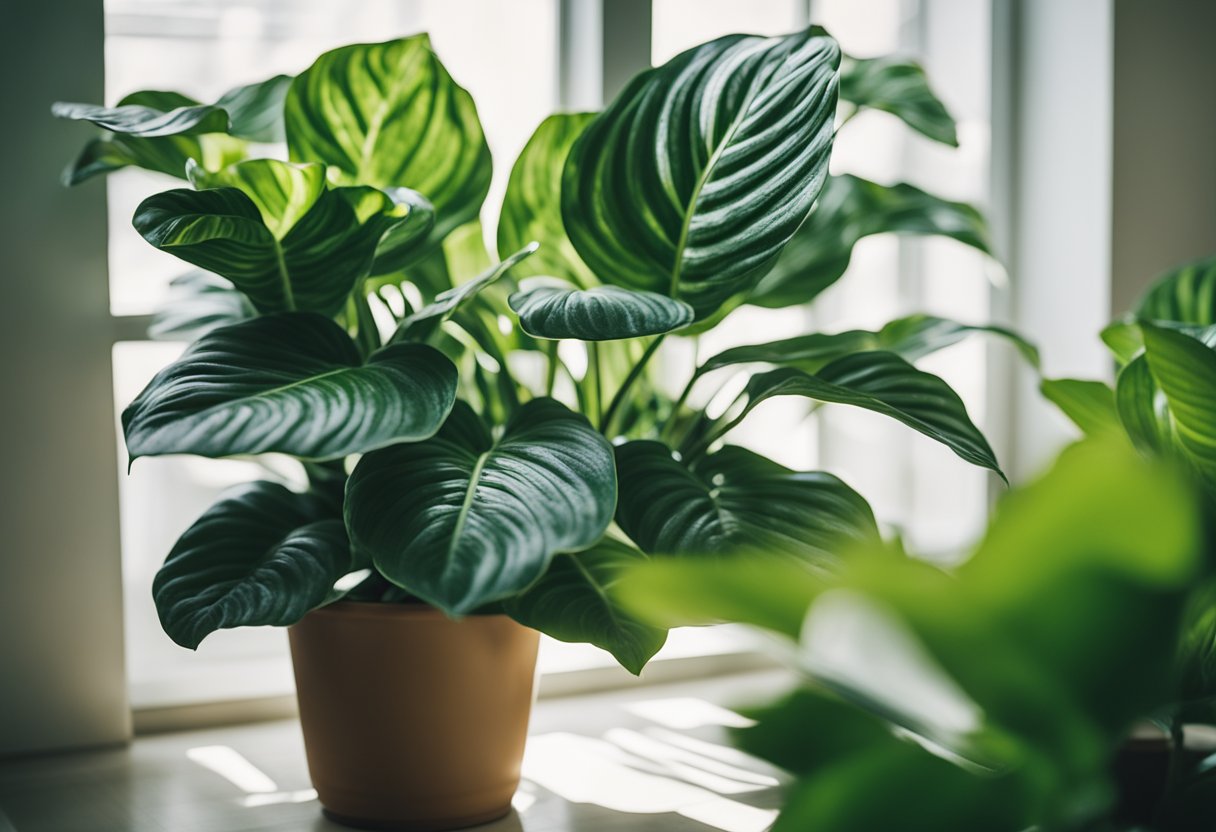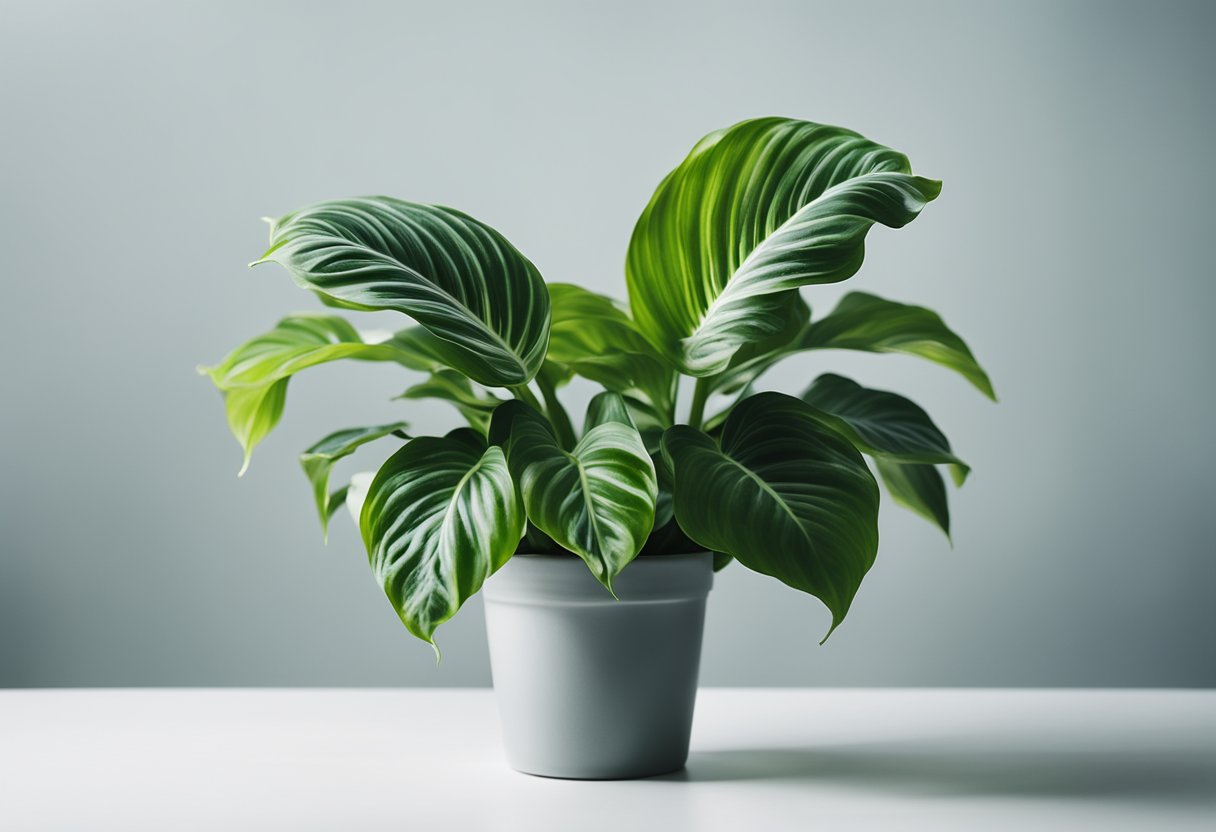As a houseplant enthusiast, I have come across many different types of plants with unique needs and characteristics. One plant that has caught my attention recently is the Calathea, known for its stunning leaves with intricate patterns and vibrant colors.
However, I have also noticed that many Calathea owners have struggled with leaves curling, which can be frustrating and concerning. In this article, I will explore the causes and solutions for Calathea leaves curling, so that you can keep your plant healthy and thriving.

Understanding Calathea Leaves Curling is important because it can indicate underlying issues with the plant. The first step is to identify what type of curling is occurring, as there are different types with different causes.
Curling can be upward or downward, and can affect the entire leaf or just the edges. Once the type of curling is identified, it is important to look at the environmental factors that may be contributing to it. This can include humidity levels, temperature, light, and water. By understanding these factors, you can make adjustments to create a more suitable environment for your Calathea.
Key Takeaways
- Understanding the different types of Calathea leaf curling is important for identifying underlying issues.
- Environmental factors such as humidity, temperature, light, and water can contribute to leaf curling.
- Making adjustments to the plant’s environment can help prevent and solve leaf curling issues.
Understanding Calathea Leaves Curling
As a plant enthusiast, I understand the frustration that comes with seeing your Calathea leaves curling. This section will help you better understand the reasons behind this phenomenon and how to identify signs of stress in your Calathea plant.
Typical Growth Patterns
Calathea plants are known for their unique and beautiful foliage. However, their leaves are also known to curl, which is a natural growth pattern for this plant. During the day, the leaves will extend outward to absorb sunlight, and at night, they will curl up to conserve moisture.
Signs of Stress in Calathea
While curling leaves are a natural part of the Calathea’s growth pattern, there are other signs of stress that you should look out for. Here are some common signs that your Calathea plant may be experiencing stress:
- Wilting leaves: This is a sign that your plant is not getting enough water.
- Yellowing leaves: This could be caused by overwatering or underwatering, so it’s important to check the soil moisture level.
- Brown tips: This is usually caused by dry air or a lack of humidity. Consider misting your plant or using a humidifier.
By understanding the typical growth patterns of Calathea plants and recognizing signs of stress, you can help your plant thrive and prevent further damage. Remember to monitor your plant’s soil moisture level, provide adequate humidity, and avoid overwatering.
Environmental Factors Causing Leaf Curl

Calathea plants are sensitive to environmental changes, and leaf curling is a common symptom of stress. In this section, I will discuss the environmental factors that can cause Calathea leaves to curl and how to address them.
Inadequate Watering
Underwatering or overwatering can cause Calathea leaves to curl. If the soil is too dry, the leaves will curl to conserve moisture. Conversely, if the soil is too wet, the roots may suffocate, and the leaves will curl as a result.
To prevent this, I recommend checking the soil moisture level regularly and adjusting your watering schedule accordingly. Calathea plants prefer consistently moist soil, but not waterlogged soil. A good rule of thumb is to water when the top inch of soil feels dry to the touch.
Low Humidity Levels
Calathea plants are native to tropical regions and thrive in high humidity environments. Low humidity levels can cause the leaves to curl as the plant tries to retain moisture.
To increase humidity levels, I suggest using a humidifier or placing a tray of water near the plant. Misting the leaves can also help, but be careful not to overdo it, as too much moisture can lead to fungal growth.
Temperature Extremes
Calathea plants prefer temperatures between 65-80°F (18-27°C). Exposure to temperatures outside of this range can cause the leaves to curl.
To prevent this, I recommend placing your Calathea in a room with consistent temperatures and avoiding areas with drafts or direct sunlight. If the temperature drops below 60°F (15°C), the plant may go into shock and drop its leaves.
Poor Light Conditions
Calathea plants prefer bright, indirect light. If the plant is exposed to direct sunlight or low light conditions, the leaves may curl as a protective mechanism.
To prevent this, I suggest placing your Calathea near a north or east-facing window, or using a sheer curtain to filter the light. If the leaves are curling due to low light levels, consider supplementing with artificial light, such as a grow light.
By addressing these environmental factors, you can prevent Calathea leaves from curling and keep your plant healthy and thriving.
Cultural Practices and Leaf Curl
As I mentioned earlier, cultural practices play a significant role in the health of your Calathea plant. Here are some cultural practices that can cause leaf curl:
Improper Soil Mix
Calathea plants prefer well-draining soil that is rich in organic matter. If the soil mix is too dense, it can cause the roots to suffocate and lead to leaf curl. On the other hand, if the soil mix is too light, it can cause the plant to dry out quickly, which can also lead to leaf curl.
To avoid this, I recommend using a soil mix that is specifically designed for Calathea plants. You can also make your own soil mix by combining equal parts of peat moss, perlite, and vermiculite.
Overfertilization
Overfertilizing your Calathea plant can cause leaf curl, as well as other issues such as root burn and yellowing leaves. It’s important to follow the instructions on the fertilizer package and only fertilize your plant during the growing season (spring and summer).
If you notice that your plant is showing signs of overfertilization, such as brown tips or leaf curl, you can flush the soil with water to remove any excess fertilizer.
Pest Infestations
Pests such as spider mites and mealybugs can also cause leaf curl in Calathea plants. These pests feed on the plant’s sap, which can cause the leaves to curl and become distorted.
To prevent pest infestations, I recommend regularly inspecting your plant for any signs of pests. If you do notice any pests, you can use insecticidal soap or neem oil to get rid of them.
By following these cultural practices, you can help prevent leaf curl in your Calathea plant and keep it healthy and thriving.
Troubleshooting and Diagnosing
Visual Inspection
When troubleshooting and diagnosing curling leaves on your Calathea plant, the first step is to visually inspect the plant. Look for any signs of pests, such as spider mites or mealybugs, as they can cause leaves to curl. Check the undersides of the leaves for any webbing or small insects.
Inspect the leaves themselves for any discoloration or spots, which could indicate a fungal or bacterial infection. If the leaves are also drooping or wilting, it could be a sign of overwatering or underwatering.
Soil Moisture Check
Next, check the soil moisture level. Calathea plants prefer consistently moist soil, but not waterlogged soil. Stick your finger about an inch into the soil and check for moisture. If the soil feels dry, it’s time to water your plant. If the soil feels wet, hold off on watering for a few days.
Overwatering can cause roots to rot and lead to curling leaves, so make sure the soil has proper drainage and that you’re not watering the plant too frequently.
Environmental Monitoring
Lastly, monitor the plant’s environment. Calathea plants prefer warm, humid environments with indirect sunlight. If the air is too dry, the leaves may curl as a defense mechanism to conserve moisture. Consider using a humidifier or placing a tray of water near the plant to increase humidity.
If the plant is in direct sunlight, move it to a shadier location. Too much direct sunlight can cause the leaves to curl and become scorched.
By visually inspecting the plant, checking soil moisture levels, and monitoring the environment, you can troubleshoot and diagnose the cause of curling leaves on your Calathea plant.
Solutions and Preventative Measures

Correct Watering Techniques
Proper watering is crucial to prevent Calathea leaves from curling. Overwatering can cause root rot, while underwatering can cause the leaves to wilt and curl. I recommend watering the plant once a week, allowing the soil to dry out slightly between waterings. Use a well-draining soil mix and ensure that the pot has drainage holes.
Humidity Control
Calathea plants thrive in high humidity environments. To prevent leaf curling, maintain a humidity level of at least 50%. You can increase humidity by placing a humidifier near the plant or by placing a tray of water near the plant. Misting the leaves with water can also help increase humidity.
Temperature Regulation
Calathea plants prefer warm temperatures between 65-85°F (18-29°C). Exposure to cold drafts or temperatures below 60°F (15°C) can cause leaf curling. Keep the plant away from air conditioning vents and windows during the winter months.
Appropriate Lighting
Calathea plants prefer bright, indirect light. Direct sunlight can scorch the leaves and cause them to curl. Place the plant near a north or east-facing window or provide filtered light with a sheer curtain.
Soil and Fertilization Management
Calathea plants require well-draining soil that is rich in organic matter. Fertilize the plant once a month during the growing season with a balanced fertilizer. Avoid over-fertilization, as this can lead to salt buildup in the soil, which can cause leaf curling.
Pest Management
Pests such as spider mites and mealybugs can cause stress to the plant, leading to leaf curling. Inspect the plant regularly and treat any infestations promptly with an insecticidal soap or neem oil. Avoid using chemical pesticides, as they can harm the plant and the environment.
By following these solutions and preventative measures, you can help prevent Calathea leaves from curling and ensure a healthy, thriving plant.
Long-Term Care for Calathea

Routine Maintenance
To keep your Calathea healthy in the long-term, it is important to establish a consistent routine for its care. This includes watering, fertilizing, and cleaning.
I recommend watering your Calathea once a week, making sure to thoroughly soak the soil. It is important to avoid letting the soil dry out completely, as this can cause the leaves to curl. Additionally, Calathea plants prefer high humidity, so misting the leaves or using a humidifier can be beneficial.
Fertilizing your Calathea every two months with a balanced fertilizer can also help promote healthy growth. Be sure to follow the instructions on the fertilizer package and avoid over-fertilizing, as this can damage the plant.
Finally, regularly cleaning your Calathea’s leaves can help prevent pests and keep the plant looking its best. Gently wipe the leaves with a damp cloth or sponge to remove dust and debris.
Seasonal Adjustments
As the seasons change, it is important to adjust your Calathea’s care routine accordingly. During the winter months, when the air is drier, you may need to increase the humidity around your plant by misting or using a humidifier more frequently. Additionally, you may need to reduce the frequency of watering to avoid over-saturating the soil.
During the summer months, when the air is more humid, you may need to water your Calathea more frequently to prevent the soil from drying out. You may also need to adjust the location of your plant to avoid direct sunlight, which can scorch the leaves.
Repotting and Root Care
Over time, your Calathea may outgrow its pot and require repotting. This is typically necessary every 1-2 years, or when the roots begin to outgrow the pot.
When repotting, choose a pot that is one size larger than the current pot and use a well-draining potting mix. Gently loosen the roots and remove any dead or damaged roots before placing the plant in the new pot.
Regularly checking the roots of your Calathea can also help prevent root rot, which can be caused by over-watering or poor drainage. If you notice any signs of root rot, such as mushy or discolored roots, take immediate action to correct the issue. This may include reducing watering, improving drainage, or repotting the plant.
Also Read | Butternut Squash Growing Stages: A Guide to Harvesting Your Own Squash
FAQs – Calathea Leaves Curling
What causes Calathea leaves to curl and how can it be remedied?
Calathea leaves curling is a common issue that can be caused by several factors. The most common cause of curling leaves is a lack of humidity. Calathea plants thrive in high humidity environments, so if the air is too dry, the leaves will curl up to conserve moisture. Other causes of curling leaves include overwatering, underwatering, too much direct sunlight, and pests. To remedy this issue, try misting the leaves regularly, placing a humidifier nearby, and keeping the plant away from direct sunlight. Adjusting the watering schedule and treating any pest infestations can also help.

How can you tell if a Calathea is being overwatered, and what are the steps to fix it?
Overwatering is a common problem with Calathea plants and can cause the leaves to curl and turn yellow. To determine if your plant is overwatered, check the soil for moisture. If the soil feels consistently wet or waterlogged, it’s a sign of overwatering. To fix this issue, stop watering the plant for a few days and allow the soil to dry out. You may also need to repot the plant into fresh, well-draining soil to prevent future overwatering.
Why do Calathea leaves curl after repotting, and what should be done to alleviate the stress?
Repotting can be stressful for Calathea plants, and curling leaves are a common symptom of this stress. The plant may be experiencing shock from the change in environment or damage to its roots during the repotting process. To alleviate the stress, keep the plant in a shaded area and avoid fertilizing or overwatering for a few weeks. The plant should recover on its own over time.
What are the reasons behind Calathea leaves turning crispy, and how can this be corrected?
Crispy Calathea leaves are usually caused by underwatering or exposure to dry air. When the plant doesn’t receive enough water, the leaves will dry out and become crispy. To fix this issue, increase the frequency of watering and mist the leaves regularly. You can also place a humidifier nearby to increase the humidity in the air.
Why do Calathea leaves droop, and how can you help them recover?
Drooping Calathea leaves are a sign of underwatering or overwatering. If the soil is consistently dry, the plant needs more water. If the soil is consistently wet, the plant is being overwatered. Adjusting the watering schedule can help the plant recover. If the plant has been overwatered, it may also need to be repotted into fresh, well-draining soil.
Is it possible for curled Calathea leaves to return to their normal state, and what methods assist in their recovery?
Yes, it’s possible for curled Calathea leaves to return to their normal state with proper care. Misting the leaves regularly, increasing humidity, adjusting the watering schedule, and providing the plant with the right amount of light can all help the plant recover. However, it’s important to note that some damage may be irreversible, and the plant may need to grow new leaves to fully recover.